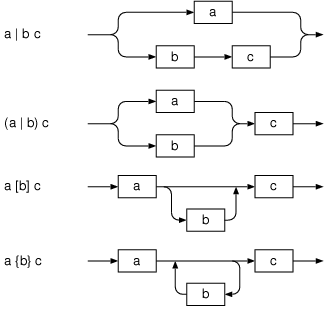
| Home/ | www.icosaedro.it |  |
 BNF Syntax Validator and Formatter
BNF Syntax Validator and FormatterLast update: 2024-03-12
bnf_chk validator and formatter for the EBNF (Extended Backus-Naur Form) syntax. Two implementations are also available:
 JavaScript implementation which
can be used on-line and can also be saved locally on your computer.
Recommended if you want to use the program for your works.
JavaScript implementation which
can be used on-line and can also be saved locally on your computer.
Recommended if you want to use the program for your works.
Features
EBNF Syntax
Try BNF_CHK on-line
Download
The program presented here lets you check the formal validity of a set of EBNF declarations. Given a text file containing the EBNF declarations, the program bnf_chk can:
The program parses a common EBNF syntax like this, describing integer and floating point numbers:
digit = "0".."9";
integer = ["+"|"-"] digit {digit};
real = integer "." digit {digit} [ "E" integer ];
These rules say that a digit is any character between 0 and 9, an integer number is a sequence of one or more digits with possibly a leading sign, and a real number is just like an integer with a fractional part and possibly a scale factor. These declarations can be reformatted with the command
$ bnf_chk --print-html --print-index numbers.txt
giving as output the HTML version that follows:
1. digit ="0".."9";
2. integer = ["+"|"-"] digit1 { digit1 } ;
3. real = integer2"."digit1 { digit1 } ["E"integer2 ] ;
The program is released as freeware.
A file that BNF_CHK can parse must be a sequence of zero or more rules. The special character "#" starts a comment and all the characters up to the end of the line are ignored.
Rules.
Every rule begins with its rule identifier, followed by an equal sign
=, followed by an expression and terminated by semicolon:
identifier
=
expression
;
Rule identifiers. Any sequence of letters, digits and underscore starting with a letter or an underscore is a rule identifier (non-terminal symbol).
Expressions. An expression is one or more terms separated by a vertical bar:
term1
|
term2
|
term3
Terms. A term is a product of factors. Factors can be simply written in the order, no "product" symbol is required. Spaces are allowed to separate contiguous identifiers.
Factors. A factor can be:
some_rule"some text""A".."Z"[expression]{expression}(a|b|c).
Literal words of the language must be enclosed within double quotes.
Only ASCII printable characters are allowed. The character double quote
itself can be expressed through the special sequence \"
(backslash, double quote) and the character backslash can be expressed as
\\ (backslash, backslash).
Commonly used escaped sequences "\a\b\n\r\t" are also allowed.
Any other byte can be expressed in hexadecimal form as \xHH
where HH are two hexadecimal digits.
The new JavaScript implementation also supports UTF-16 characters encoded
as "\uHHHH".
The figure below illustrates some features of the EBNF syntax through syntax diagrams: the square boxes are the rules, while the arrows indicate the allowed paths between rules.

Algebraic syntax and syntax diagrams compared.
The EBNF syntax allowed by the program can be expressed in terms of the EBNF syntax itself as follows:
1. bnf_file = { rule2 } ;
2. rule = identifier3"="expression6";";
3. identifier = ( letter4 |"_") { letter4 | digit5 |"_"} ;
4. letter ="a".."z"|"A".."Z";
5. digit ="0".."9";
6. expression = term7 {"|"term7 } ;
7. term = factor8 { factor8 } ;
8. factor = identifier3 | literal9 | range10 |"("expression6")"|"{"expression6"}"|"["expression6"]";
9. literal ="\""{ char11 }"\"";
10. range ="\""char11"\"""..""\""char11"\"";
11. char = plain_char12 | escaped_char13 | hex_char14 ;
12. plain_char =" ".."\x7f"|"\x80".."\xff"| utf_16_char15 ;
13. escaped_char ="\\"("\""|"\\"|"a"|"b"|"n"|"r"|"t") ;
14. hex_char ="\\x"hex16 hex16 ;
# UTF-16 chars are supported only by the new JavaScript implementation:
15. utf_16_char ="\\u"hex16 hex16 hex16 hex16 ;
16. hex ="0".."9"|"a".."f"|"A".."F";
Two implementations are available:
 JavaScript implementation which
can be used on-line and can also be saved locally on your computer.
Recommended if you want to use the program for your works.
JavaScript implementation which
can be used on-line and can also be saved locally on your computer.
Recommended if you want to use the program for your works.
Here are some examples of BNF definitions:
File Size Description bnf_chk-windows-1.4_20061107.zip68 KB Executable program tested on Microsoft Windows Vista. Users of Windows that intend simply to use the program, should download only this package. bnf_chk-pure-c-1.4_20061107.tar.gz27 KB This version of the program is the output of the M2-to-C cross compiler. To successfully generate the executable program you only need a C compiler like gcc under Linux or Unix. bnf_chk-1.4_20061107.tar.gz30 KB Original M2 source of BNF_CHK. Requires the M2 development system, available at www.icosaedro.it/m2.
The source program is also browsable throught the CVS server, from which you can also download the latest version of the program under development.
| Umberto Salsi | Comments | Contact | Site map | Home/ |
An abstract of the latest comments from the visitors of this page follows. Please, use the Comments link above to read all the messages or to add your contribute.
2011-09-19 by Guest
comments
comment sections (* comment *) gave fatal error[more...]
2009-12-21 by Umberto Salsi
Re: EBNF
Anonymous wrote: [...] I would to remember you all to read the specifications about my little program (click on the "Section index" link above) where the exact syntax the program accepts is clearly explained. About the repetition factor, the syntax 3*A can be easily converted to A A A without commas. [more...]
2009-12-11 by Guest
Re: EBNF
Anonymous wrote: [...] The syntax checker also does not understand the repetition syntax above, such as bb = 3 * aa, "B";[more...]
2009-03-05 by Guest
EBNF
It seems that your EBNF syntax checked does not understand ','. In EBNF it is called 'concatenate-symbol'. Eample from ISO 17977: bb = 3 * aa, "B"; cc = 3 * [aa], "C"; Your checker does not understand comma here.[more...]